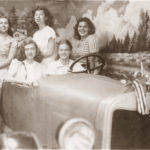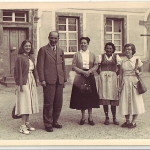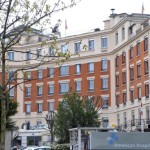Warning: You are about to read a cerebral, somewhat dry, blog.
There is nothing like starting a new project to become aware of one’s profound ignorance on the subject. Difficult as I knew conditions were in Europe after the war, I had not thought about how tourism was all but impossible in the first years after the war. Not only was most transportation and lodging dedicated to soldiers, diplomats, and other non-tourists, but hotels were often in dilapidated shape and food was often substandard or scarce. And, of course, many of the buildings, exhibits and festivals normally attended by tourists were bombed, closed, under repair, or suspended.
I’ve learned these facts from my conversations this summer, from a book called Cold War Holidays by Christopher Endy, and from reading a number of New York Times articles from 1949. In his book, Endy details the complex and often fraught process of re-introducing tourism into Europe after World War II. Endy highlights two contrasting aspects of postwar tourism. He notes, on the one hand, how difficult and unwieldy it was to encourage tourism after the war–particularly given the lack of amenities for tourists and the lack of funds for investing in tourist hotels, restaurants, etc… On the other hand, many American and European officials felt that the encouragement of tourism was consistent with–even part of–the Marshall Plan, which had begun in 1948, hence there was a willingness to invest many American dollars into the European tourism industry, given a belief that the influx of American tourists, with their dollars, would help jump start the European economy. While different European countries responded differently to this idea, Endy stresses how “U.S. and French government officials subsidized transatlantic air and shipping lines, funded hotel construction and maintenance, negotiated airport landing rights, organized publicity campaigns, controlled passport and visa requirements, and, in the first years after the war, provided tourists and the travel industry in France with special access to scarce food and gasoline” (4).
To put it in Endy’s words, “State support … was indispensable in tourism’s rise.” (4). In other words–“dollar diplomacy.” Interestingly, the need to support Europe financially via tourism was not because Europe’s infrastructure and industries were totally destroyed; in fact, Endy notes that, by the end of 1946, European industrial production had returned to its pre-war levels. However, trade and currency imbalances were so strong as to threaten this remarkable recovery (56). Europe, in other words, needed dollars, and it needed Americans who would buy European goods with these dollars and bring the goods back to America.
Those in the tourist industry were certainly enthusiastic about using the Marshall Plan in this manner. In a 1949 article for the New York Times, Heather Bradley notes how one prominent member gave a speech in which he “told delegates that 1950 is expected to break all former American records for overseas travel, even topping the volume of 1930, which at present holds the record for United States travel abroad.” While in a January 4, 1949 article, Jonathan Frayman adds that the tourist industry was “rivaled only by cotton textiles” as the source of income for Great Britain, ahead of “automobiles, Scotch whisky”
The leitmotif of 1949 in newspaper articles about tourism to England is the way that Britain relaxed its austerity measures to accommodate tourists. Joseph Frayman notes how, in England–where gasoline was still rationed–“tourists immediately get enough gasoline coupons to cover their rental car itineraries, hotels have received extra sheets, and eggs are not rationed in hotels” (NYT May 6, 1949). However, not all was easily available and Frayman goes on to suggest that tourists from the States should bring with them “reasonable quantities of food, as well as candies and cigarettes,” particularly given the high tax on cigarettes in Britain.
Yet, as Endy goes on to note, this well-intentioned perspective on tourism-as-economic-incentive led to some controversy; once some European countries gave special services to tourists (subsidies to hotels to improve their rooms, or better rations for American tourists), many citizens resented the fact that Americans tourists–who were already far better off economically than they were–were getting special services and economic subsidies, subsidies that took money and rations away from the many still-impoverished European citizens. Not to mention that many saw the influx of American tourists as creating “a metaphorical colonization by the United States” (8).
And, not surprisingly, Communist and Socialist groups in Europe looked askance at subsidizing the leisure time and the consumption of commodity fetish items by a bunch of American bourgeois capitalists (67).
If many Europeans felt this way, it appears that none of the four travelers seems to have experienced this resentment. The response of those whom they met seems more to have been interest, gratitude, and curiosity.
What I’ve also learned from Endy’s book is that these four women reflected the slow growth of tourism after the war. Travel to Europe for the first year after the war was restricted to servicemen, refugee organizations, and business executives who traveled under the approval of the State Department. Before the war a typical year saw 359,000 trips from America to Europe. In 1946 it was down to 101,000 trips; in 1947 it increased to 147,000–most of them visitors to France. And, according to the New York Times in 1948 alone 500,000 tourists (world-wide) visited Britain (NYT Feb 19, 1949), of which 75,000 were Americans–and this was just Britain. The writer adds that this was “the biggest influx of overseas visitors for twenty-eight years.” He adds that “Of these, …. the largest proportion came on pleasure trips.”
But 1949 seems to have been the first year in which enough tourists returned that governments and townships returned to the festivals so characteristic of major cities and to beautiful rural areas, particularly during tourist season. Indeed, by 1950 the visits were up to 264,700. One article in the New York Times notes the return of festivals by dwelling on “The Shakespeare festival at Stratford-upon-Avon, … the National Drama Festival at Harrogate, … and the Edinburgh Festival,” along with a number of exhibitions throughout England (Joseph Frayman Mar 6, 1949). Indeed, my mother reminded me that, by 1949, the small German town of Oberamergau was once more ready for its Passion Play, put on by the village every ten years starting in 1634, and to which the village dedicated a full year of preparation. While this production would not be presented until 1950, by the time that my mother, Joan, Anissa, and grandmother came to Oberamergau, most of its male population was under an edict not to cut their hair or beards. My mother remembers beautiful young men with long blond hair coming to take their bags, men who were also, she added “very, very dirty.” 1949 indeed seems to have been the first year in which European countries felt they were able to roll out the red carpet for tourists, while 1950 seems to be the year that American tourists really decided to start pouring back in. I wonder if the mere fact that 1950 symbolized the end of the grim 1940’s meant that Americans felt comfortable traveling transatlantically again.
American newspapers certainly picked up on this re-emergence of tourism. The New York Times has headlines from 1949 that include “Britain Relaxes Austerity for the Tourist,” “Tourists to Britain at 500,000 in 1948,” and “Tourists Shower Dollars in Britain.”
As we will see, the four travelers encountered both Europes–the Europe of deprivation, difficulties, rations, and the Europe of festivals, growing prosperity, and increasing tourism. Despite all the difficulties with overheated Citroens, visa issues, and challenging eating options, nonetheless, there remains my grandmother’s anthem: “That was when the dollar was king!”
Alas–the travelers arrived a bit early, and so did not experience the great devaluation of the pound in September. Just as Londoners saw an upswing in productivity and a radical lessening on all rations, they were hit by a 30% devaluation of the pound. A boon for Americans, and a bit of a boon for England, as tourists–most of them Americans showered $49,000,000 on London in 1948 and even more in 1949. Small wonder that one New York Times headline of September, 1949 is “American Buying Spree Hits London.” There are of course drawbacks to this advantage. As Joseph Frayman notes, hotel staff members “still think that every visiting American is rich. There is no need to encourage that erroneous impression: 10 per cent [tip] is ample.” The author of a New York Times article from September 1949 added that, according to Cornelius Vanderbilt Whitney, Under-Secretary of Commerce, “A good many who visited Europe this year (1949) returned with the unhappy feeling that they had been overcharged on the Continent and with disappointment at the drabness and troublesome restrictions in Britain.”
Our travelers do not seem to have been “taken for a ride,” and they don’t report an experience of drabness per se–except for meals. Instead, they had to deal with some European eccentricities–magnified by the remaining traces of the war–focused mainly on plumbing, heating, and mattresses.



Really interesting. The little I know about the trip from Mommy, that describes it perfectly–joyfulness with the “reopening” of Europe alongside limited ammenities. I’ve heard her mention many times how incredibly affordable the hotels were.